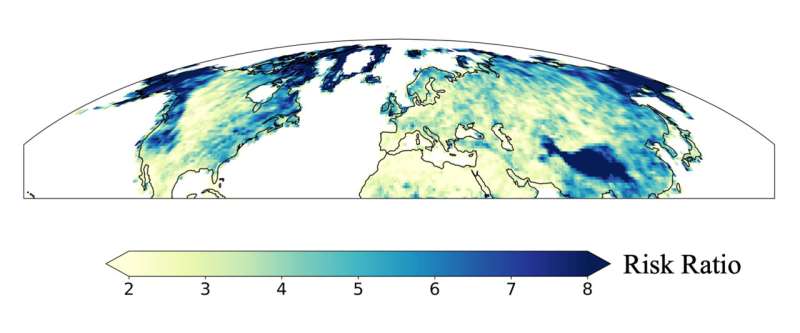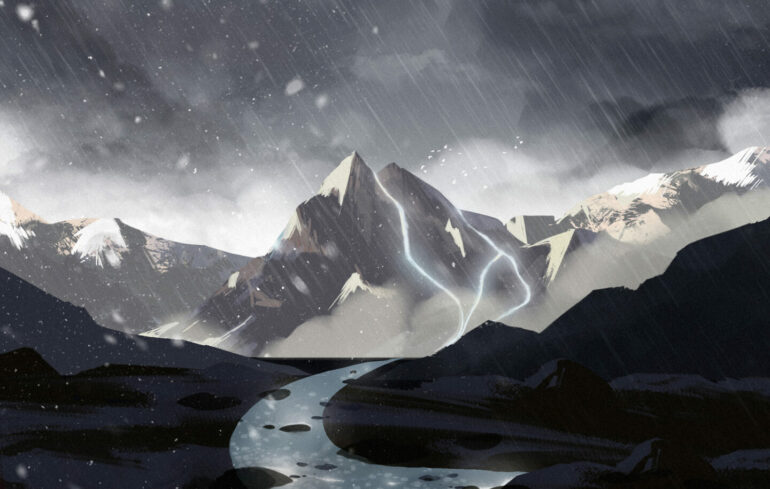As the world warms, extreme weather events grow—and they also change. Researchers at the Department of Energy’s Lawrence Berkeley National Laboratory (Berkeley Lab) found that climate change is shifting snowfall to rainfall on mountains across the Northern Hemisphere. Those surges of liquid water bring a distinct set of dangers, including floods, landslides, and soil erosion.
“One quarter of the global population lives in or downstream from mountainous regions,” said Mohammed Ombadi, first author of the paper published in Nature. “They are going to be directly affected by this risk.”
Scientists already expect climate change to increase the volume of water falling during extreme events (which typically take place over a few hours to a day), but this study is the first time researchers have looked at whether that extreme precipitation comes as rain or snow.
They found that the fraction of water falling as snow decreased in mountainous regions, falling instead as rain—making mountains particularly susceptible to extreme rain hazards. They even put a number to it: For every 1° Celsius increase in the global temperature, researchers expect an average of 15% more rain at high elevations.
“This increase in rainfall extremes is not only something that is going to happen from now until the end of the 21st century—we’re already seeing it,” Ombadi said. “That same rate was also evident in the data from 1950 to 2019. Rainfall extremes in mountains have already been increasing, and will continue to change with that 15% rate.”
While all the mountain ranges in the Northern Hemisphere are seeing the shift from snow to rain, those at greatest risk of extreme rainfall events are the North American Pacific mountain ranges (the Cascades, Sierra Nevada, and coastal ranges from Canada to Southern California), the Himalayas, and high-latitude regions. Researchers are still working to understand why those areas are at higher risk than other mountain ranges such as the Rockies or the Alps.

This map shows the projected risk of rainfall extremes by the end of this century. Areas in the darkest blue are eight times more likely to experience an extreme rainfall event (compared to 1950-1979). Mountainous (high-elevation) and northerly (high-latitude) regions are at the greatest risk. © Mohammed Ombadi/Berkeley Lab
“We think that North American Pacific mountain ranges are more susceptible to the risk of rainfall extremes than other mountain ranges because a significant portion of snowfall in this region typically occurs at temperatures just below zero degrees Celsius,” Ombadi said. “The slightest change in air temperature will shift this snowfall to rainfall. This is unlike other mountain ranges where snowfall may occur at very low temperatures below zero degrees.”
Ombadi hopes that fellow climate scientists will incorporate the distinction between snowfall and rainfall to improve global climate models, and that civil engineers and planners will use the data to better prepare for intense rain events.
“We need to factor these results into how we design and build the infrastructure in these mountainous regions, so that they can withstand the negative consequences of increases in rainfall extremes,” Ombadi said.
Meanwhile, countries continue efforts to meet targets established by the Paris Agreement that would limit global warming to less than 2° Celsius above pre-industrial levels.
“Our findings revealed a linear relationship between the level of warming and the increase in extreme rainfall: For instance, 1° of warming causes 15% more rain, while 3° leads to a 45% increase in rainfall,” Ombadi said. “There are many technologies in progress that could help us reduce greenhouse gas emissions and how much the planet warms. To me, this study shows the need to invest in those clean solutions, and also start preparing for the consequences of warming now.”
More information:
Mohammed Ombadi, A warming-induced reduction in snow fraction amplifies rainfall extremes, Nature (2023). DOI: 10.1038/s41586-023-06092-7. www.nature.com/articles/s41586-023-06092-7
Provided by
Lawrence Berkeley National Laboratory
Citation:
Mountains vulnerable to extreme rain from climate change (2023, June 28)



